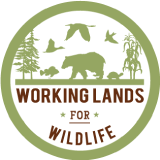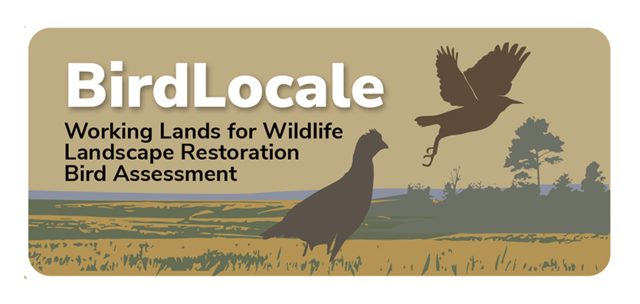-
 Building Your Own Conservation Team
Building Your Own Conservation Team
-
by
Gilbert Randolph
—
published
Jan 02, 2025
—
last modified
May 27, 2025 05:45 AM
—
filed under:
Working Lands for Wildlife,
Grasslands and Savannas,
Stories,
News,
Bobwhite,
Northern Bobwhite Quail
Building habitat on private land isn’t easy. That’s why Barb Heyen has built a “conservation team,” to help transform 120 acres of her property in southern Illinois from low quality pasture to quail and monarch-focused habitat.
Located in
Stories
-
 Bureau of Land Management (BLM)
Bureau of Land Management (BLM)
-
by
Rhishja Cota
—
published
Sep 21, 2022
—
last modified
May 23, 2024 07:38 PM
—
filed under:
WLFW,
Eastern Deciduous Forests,
Federal Agencies,
Western Landscapes,
Bureau of Land Management,
Grasslands and Savannas
The Bureau of Land Management's mission is to sustain the health, diversity, and productivity of public lands for the use and enjoyment of present and future generations.
he BLM was established in 1946, but its roots go back to the years after America’s independence, when the young nation began acquiring additional lands. At first, these lands were used to encourage homesteading and westward migration. The General Land Office was created in 1812 to support this national goal.
Over time, values and attitudes regarding public lands shifted, and President Harry S. Truman, by means of a government reorganization, merged the GLO and another agency, the U.S. Grazing Service, creating the BLM.
Located in
LP Members
/
Organizations Search
-
 Business Case for NWSG Forages w/ Dr. Pat Keyser
Business Case for NWSG Forages w/ Dr. Pat Keyser
-
by
Web Editor
—
published
Dec 30, 2020
—
last modified
Apr 21, 2023 03:36 PM
—
filed under:
Training Resources,
WLFW,
Webinars and Instructional Videos,
Northern Bobwhite Quail,
Webinar,
Grasslands and Savannas,
Working Lands for Wildlife,
Native Warm-Season Grass Forages
Day 1, Session 1. Native Warm-Season Grasses Webinar with Dr. Pat Keyser and Jef Hodges. Presented December 1, 2021.
Located in
Training Resources
/
Webinars and Instructional Videos
/
Webinar- Course on Native Warm-Season Grass Forages and Grazing Management for Bobwhites
-
Can Agriculture and Biodiversity Coexist?
-
by
Web Editor
—
published
Dec 15, 2022
—
last modified
Dec 16, 2024 04:18 PM
—
filed under:
Biodiversity,
WLFW,
Food Demand,
Northern Bobwhite Quail,
News,
Grasslands and Savannas,
Working Lands for Wildlife,
Agriculture
To free up land for biodiversity conservation while satisfying growing food demand, techno-optimist narratives suggest indefinitely increasing agricultural productivity, including through massive pesticide use. But this view, which has made its way from an academic niche into corporate and policy-making circles, overlooks the complexity of natural ecosystems and the market dynamics that regulate access to food.
Located in
News
-
CEC Monarch and Pollinator Conservation
-
by
Tab Manager
—
published
Nov 18, 2024
—
last modified
Nov 18, 2024 09:53 PM
—
filed under:
Grasslands and Savannas,
Working Lands for Wildlife,
General Resources and Publications,
WLFW,
Resources
For over two decades The Commission for Environmental Cooperation (CEC) have supported the conservation of the Monarch butterfly along its migratory route, by promoting community projects, developing action plans and supporting collaborative efforts in Canada, Mexico and the United States. Building on this model, we are supporting regional collaboration for pollinator conservation.
Located in
Resources
/
General Resources and Publications
-
 Center for Native Grasslands Management
Center for Native Grasslands Management
-
by
admin
—
published
Dec 30, 2020
—
last modified
Apr 21, 2023 12:39 AM
—
filed under:
Universities,
Partners,
WLFW,
Grasslands,
Northern Bobwhite Quail,
Grasslands and Savannas,
Working Lands for Wildlife
The Center for Native Grasslands Management provides a scientific background to producers and land managers, enabling them to effectively establish and manage native grasslands. The Center’s second major focus is to make findings from our research widely available throughout the eastern United States. We work through Extension and partner organizations to share these results with producers, land management agencies, other researchers, and wildlife conservation organizations through publications, workshops, trainings, and field days.
Located in
LP Members
/
Organizations Search
-
 Central Hardwoods Joint Venture
Central Hardwoods Joint Venture
-
by
Matthew Cimitile
—
published
Jan 07, 2014
—
last modified
May 23, 2024 07:55 PM
—
filed under:
Wildland Fire,
Grasslands and Savannas,
Golden-Winged Warbler,
Regional Partnerships,
WLFW
The Central Hardwoods Joint Venture (CHJV) is a partnership of state and federal government agencies and non-governmental organizations who work together to ensure the long-term viability of native bird populations. CHJV concentrates conservation efforts over an area comprising 75 million acres of rolling hills covered with hardwood forests interspersed with glades and woodlands and crisscrossed by deep river valleys. The area includes the Ozark Highlands, Boston Mountains, and Interior Lowland Plateaus. To protect native bird species throughout their ranges, the JV works with partners in Mexico and Canada in areas that these birds use for breeding or over-wintering.
Located in
LP Members
/
Organizations Search
-
 Commission for Environmental Cooperation (CEC)
Commission for Environmental Cooperation (CEC)
-
by
Web Editor
—
published
Nov 18, 2024
—
filed under:
CEC,
Working Lands for Wildlife,
Commission for Environmental Cooperation,
WLFW,
Grasslands and Savannas
In the context of environmental, economic and social linkages between Canada, Mexico and the United States, the CEC facilitates effective cooperation and public participation to conserve, protect and enhance the North American environment in support of sustainable development for the benefit of present and future generations.
Located in
LP Members
/
Organizations Search
-
 Cost Share Programs for landowners
Cost Share Programs for landowners
-
by
Web Editor
—
published
Feb 22, 2021
—
last modified
Apr 21, 2023 02:24 PM
—
filed under:
Training Resources,
WLFW,
Webinars and Instructional Videos,
Northern Bobwhite Quail,
Bobwhite Quail Seminar Series,
Video,
Grasslands and Savannas,
South Carolina Bobwhite Initiative,
Working Lands for Wildlife
Creating bobwhite habitat doesn't have to be expensive. SCDNR biologist Andy Krieg explains the ins and outs of a few cost share programs that are available to help you fund improvements on your property.
Located in
Training Resources
/
Webinars and Instructional Videos
/
Bobwhite Quail Seminar Series
-
 Crafting the perfect quail haven
Crafting the perfect quail haven
-
by
Rachel Holt
—
published
May 26, 2025
—
last modified
May 27, 2025 05:42 AM
—
filed under:
WLFW,
Northern Bobwhite Quail,
Grasslands and Savannas,
Prescribed Burn,
Landowner,
Habitat Management
SOUTH CAROLINA LANDOWNER’S MISSION TO RESTORE NORTHERN BOBWHITE QUAIL
Located in
Stories


